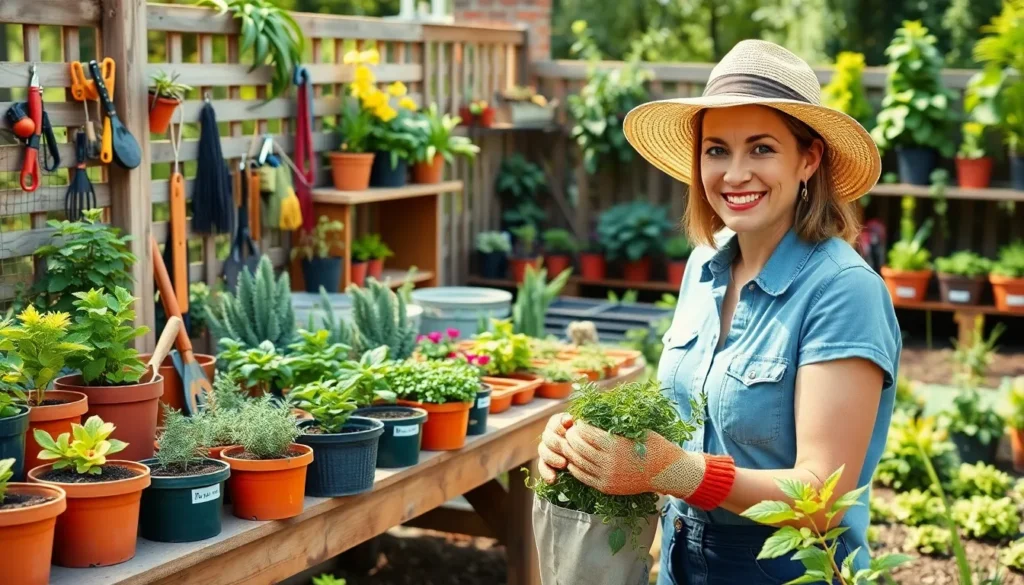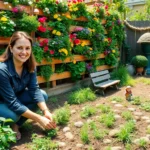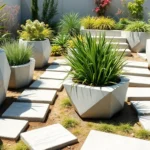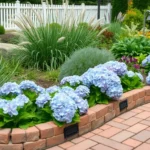A well-organized garden transforms chaotic outdoor spaces into productive havens that actually function for busy gardeners like us. Whether we’re dealing with scattered tools that disappear when we need them most or struggling to find space for our ever-growing collection of plants and supplies, poor organization kills our gardening joy faster than any pest.
We’ve all been there – frantically searching for pruning shears buried under a pile of empty pots while our tomatoes desperately need attention. The truth is, an organized garden doesn’t just look better; it saves us countless hours and makes every gardening task more enjoyable.
From clever storage answers that maximize small spaces to labeling systems that keep everything in its place, smart organization strategies can revolutionize how we approach our gardening routine. Let’s explore practical ideas that’ll turn your garden into an efficiently organized outdoor sanctuary.
Create Dedicated Storage Zones for Garden Tools
Establishing exact areas for tool storage prevents the frustrating scramble that comes with misplaced equipment. We’ll transform your garden workspace into an efficient system where every tool has its designated home.
Install Wall-Mounted Tool Racks
Wall-mounted tool racks maximize vertical space while keeping essential equipment within arm’s reach. We recommend installing these racks near your most frequently used garden areas to create convenient access points throughout your outdoor space.
Choose the right rack style for your exact tool collection. Long-handled implements like rakes, shovels, and hoes work best with horizontal rail systems that feature adjustable clips or hooks. Short-handled tools such as trowels, pruning shears, and hand cultivators benefit from vertical slot organizers that prevent tangling.
Mount racks at comfortable heights to avoid strain during daily gardening tasks. Position long-tool racks between 4 to 5 feet from ground level for easy grabbing without stretching. Place frequently used hand tools at waist height for quick access during planting and weeding sessions.
Secure mounting hardware properly to support the weight of multiple tools plus seasonal equipment loads. Use heavy-duty wall anchors rated for at least 50 pounds when mounting to siding or masonry walls. Check mounting stability monthly to ensure continued safe operation.
Build a Garden Tool Shed or Cabinet
Custom storage structures provide weather protection while accommodating larger tool collections that outgrow simple rack systems. We’ve found that dedicated sheds create centralized organization hubs that streamline garden maintenance routines.
Design storage compartments based on your exact tool inventory and usage patterns. Include tall sections for long-handled tools, medium shelving for bags of soil amendments, and small cubbies for hand tools and accessories. Add hooks along interior walls to maximize storage density.
Select weather-resistant materials that withstand seasonal temperature fluctuations and moisture exposure. Cedar and pressure-treated lumber offer natural rot resistance for wooden structures. Metal cabinets with powder-coated finishes resist rust while providing secure storage options.
Include ventilation features to prevent moisture buildup that can damage wooden handles and cause metal corrosion. Install screened vents near the roofline and consider adding small windows for natural light during tool selection tasks.
Use Pegboards for Easy Access
Pegboards create flexible storage systems that adapt to changing tool collections and seasonal equipment needs. We appreciate how these versatile organizers let you reconfigure layouts without permanent modifications to your storage space.
Install pegboards strategically in covered areas like garages, potting sheds, or covered patios where tools stay dry yet remain easily accessible. Mount boards at eye level for optimal visibility of your entire tool collection during busy gardening periods.
Customize hook arrangements to match your workflow patterns and tool shapes. Group similar implements together such as placing all pruning tools in one section and soil preparation tools in another. Use colored hooks to create visual categories that speed up tool identification.
Add supplementary storage like small bins, magnetic strips, and clipboard holders to pegboard systems for complete organization coverage. Attach mesh baskets for storing gloves, plant ties, and seed packets. Include a small whiteboard for tracking garden tasks and seasonal reminders.
Establish Efficient Potting and Work Stations
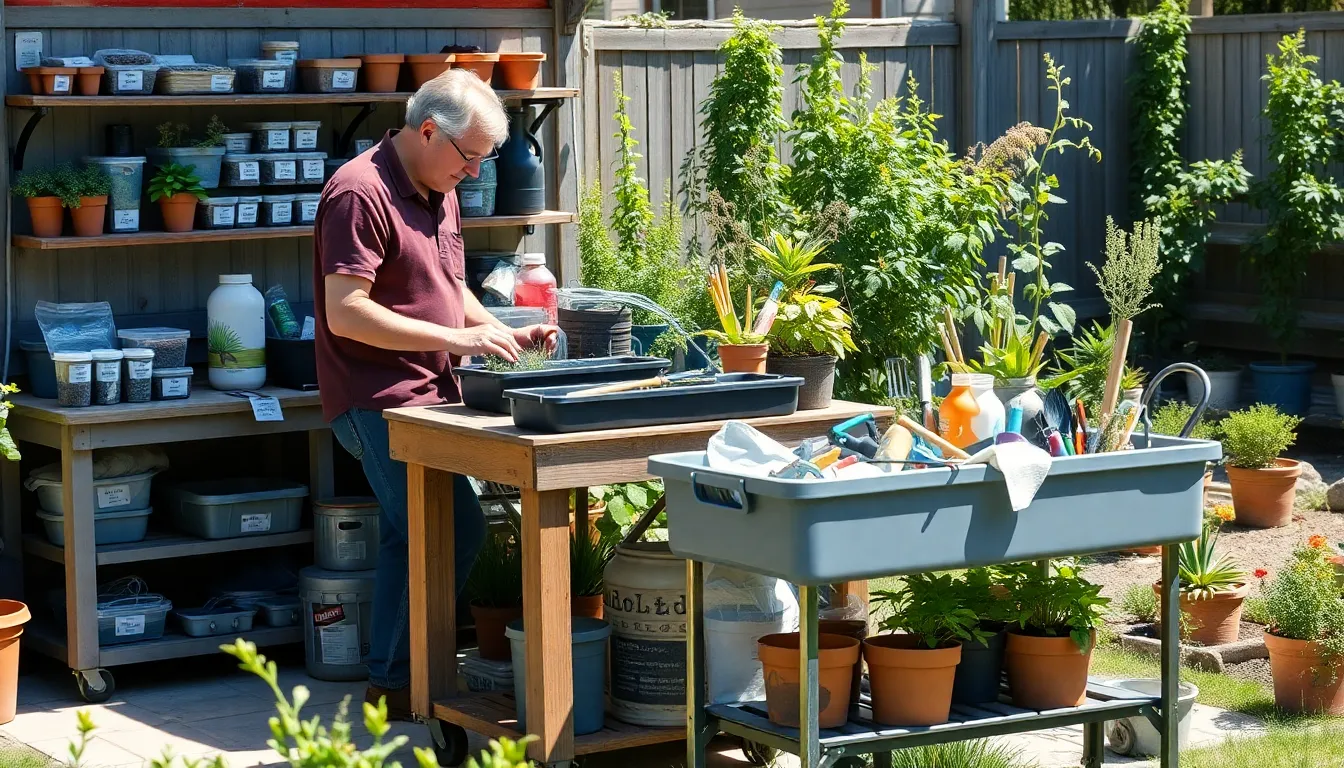
Creating centralized workspaces transforms garden organization by consolidating essential activities like planting, repotting, and soil mixing into dedicated areas. We’ll explore three key strategies that streamline your gardening workflow and keep supplies accessible.
Set Up a Dedicated Potting Bench
Customization makes your potting bench work harder for you. Tailor the workspace by adding storage compartments for tools, creating a smooth work surface, and installing a sink for convenient water access. Height matters significantly when selecting or building your bench—ensure it matches your comfortable working level to prevent back strain during extended gardening sessions.
Consolidation becomes effortless with a well-designed potting station. Position your bench to accommodate tasks like planting, mixing soil, and potting while keeping essential materials within arm’s reach. Storage drawers underneath hold seed packets, while overhead shelves store larger containers and fertilizers.
Organize Supplies with Labeled Containers
Labeled bins eliminate the guesswork when searching for gardening supplies. Store seeds, fertilizers, and small tools in clearly marked containers to maintain order and reduce time spent hunting for materials. Categories like “Spring Seeds,” “Soil Amendments,” and “Hand Tools” create logical groupings that make sense during busy planting seasons.
Vertical storage maximizes space efficiency in sheds and garages. Install wall-mounted shelves or hooks to use every inch of available space while keeping containers visible and accessible. Clear plastic bins work exceptionally well because they allow you to see contents at a peek.
Create Mobile Cart Answers
Mobile carts revolutionize how we transport tools and supplies throughout the garden. Use wheeled carts to carry everything from watering cans to pruning shears, saving countless trips back to storage areas. This mobility keeps necessary items close during extended gardening sessions.
Compartmentalization turns basic carts into organized command centers. Add bins, baskets, or custom dividers to separate different supply types—one section for tools, another for seeds, and a third for soil amendments. Weatherproof materials ensure your mobile station withstands outdoor conditions while maintaining organization.
Design Smart Seed and Plant Organization Systems
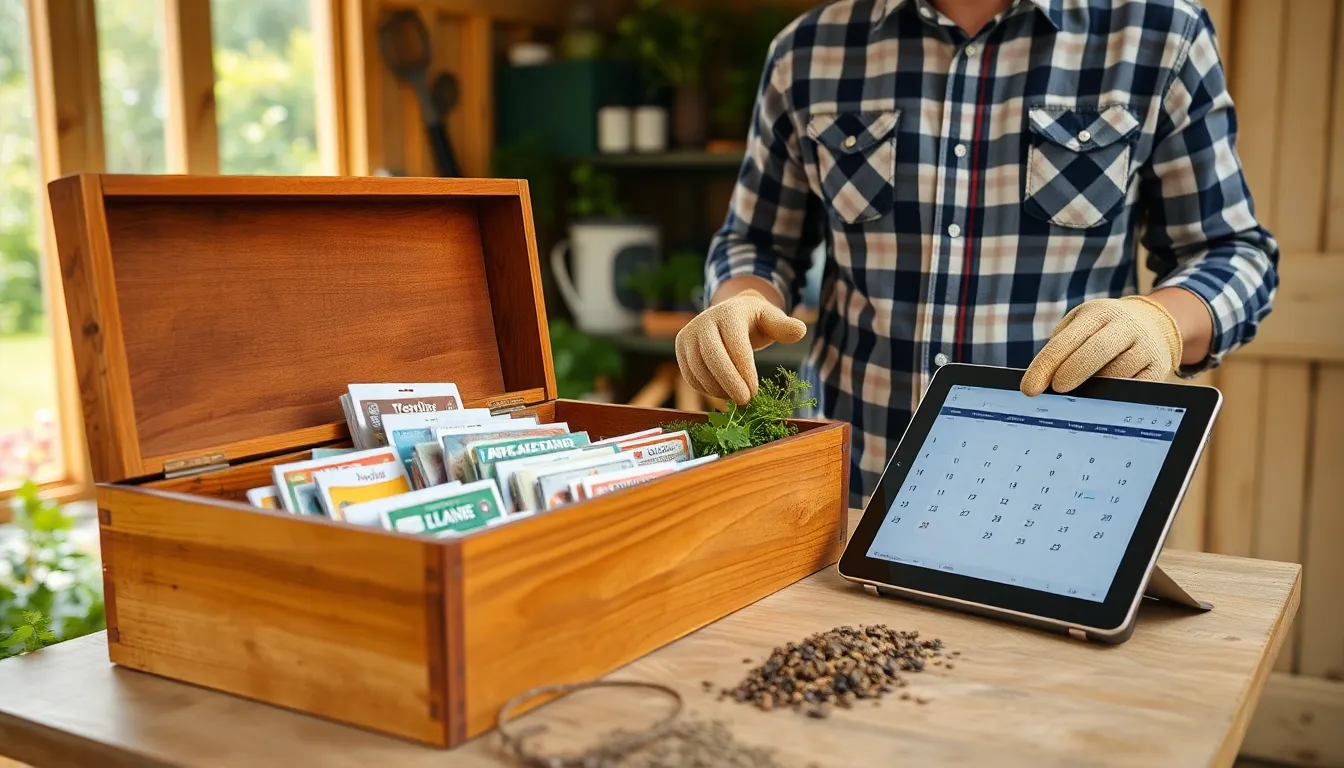
Our gardening success depends heavily on how well we organize our seeds and plants from the very beginning. Smart organization systems help us track what we’ve planted, where it’s located, and when to expect results.
Carry out Seed Storage Answers
Airtight containers protect our seeds from moisture and pests, ensuring they remain viable for future planting seasons. We recommend using wooden or plastic boxes with dividers to store seeds by type or season, making it easy to locate exact varieties when planting time arrives.
Cool, dry storage locations like basements or garden sheds maintain seed viability for extended periods. Temperature fluctuations and humidity can destroy seed germination rates, so we always store our seed collection in stable environments away from direct sunlight.
Seed boxes with labeled compartments let us categorize by planting dates, plant families, or garden zones. Small glass jars or plastic containers with tight-fitting lids work perfectly for individual seed varieties, and we can easily see contents without opening each container.
Use Plant Labels and Tracking Systems
Durable plant labels or stones mark plant names and locations throughout our garden beds, eliminating guesswork during maintenance and harvest time. Weather-resistant materials like aluminum tags or ceramic markers withstand seasonal changes better than paper or cheap plastic options.
Digital tracking through apps or spreadsheets monitors plant health, prune schedules, and pest management activities with greater accuracy than memory alone. We can record planting dates, fertilization schedules, and growth observations to improve our gardening decisions year after year.
Plant identification systems help us manage different species more effectively by providing quick reference points for watering needs, spacing requirements, and companion planting opportunities. Color-coded labels or numbered systems work particularly well for large gardens with multiple plant varieties.
Create Seasonal Planting Calendars
Calendar planning schedules planting times based on seasonal weather and plant requirements, helping us maximize growing seasons and avoid frost damage. We develop personalized calendars that account for our local climate zone and typical weather patterns.
Crop rotation planning ensures diverse soil nutrient use and reduces pest buildup between growing seasons. Our rotation schedule maps which plant families occupied each garden section, allowing us to alternate heavy feeders with nitrogen-fixing plants for healthier soil.
Succession planting schedules extend harvest periods for crops like lettuce, beans, and radishes by staggering planting dates every two to three weeks. This approach provides continuous fresh produce rather than overwhelming harvests followed by empty garden beds.
Maximize Space with Vertical Garden Organization
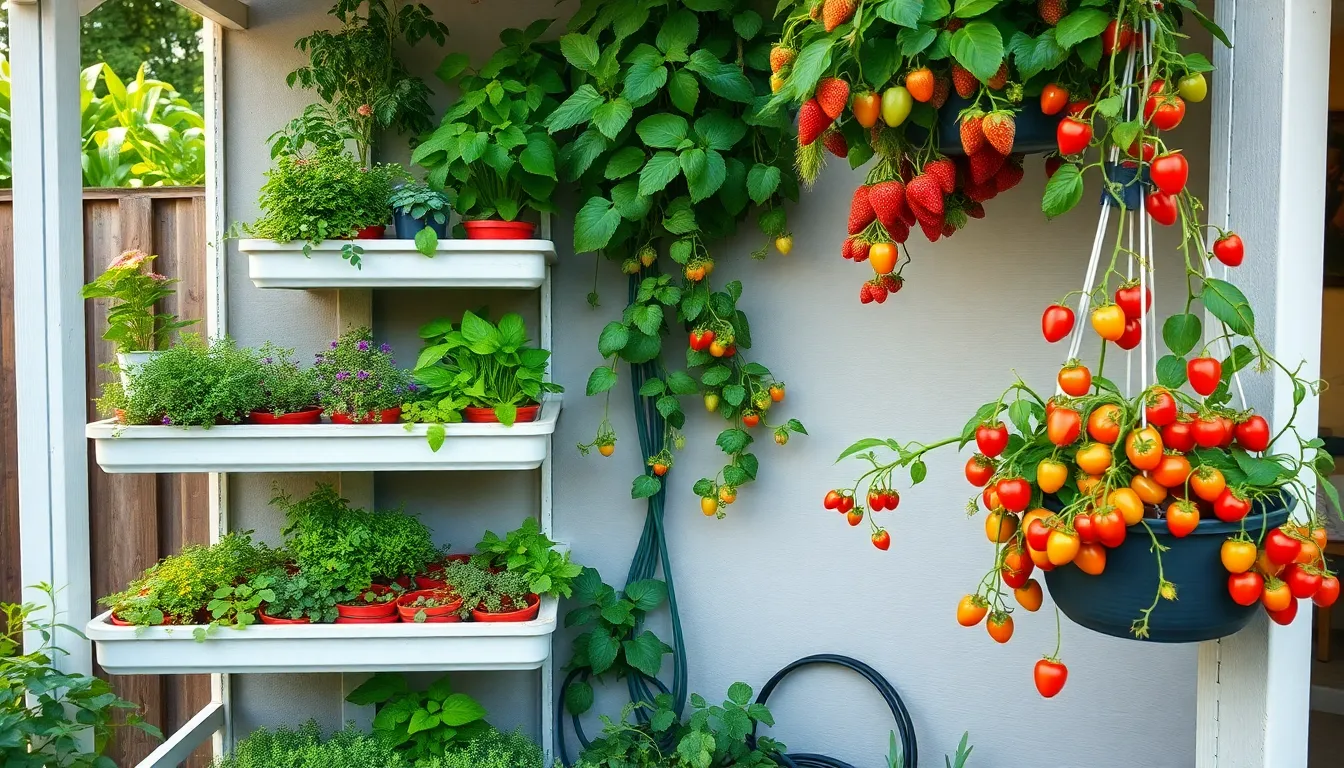
Vertical growing transforms limited garden areas into productive spaces by utilizing height rather than width. We can dramatically increase our planting capacity while maintaining organized, accessible gardens through strategic vertical techniques.
Install Tiered Plant Stands
Tiered plant stands create multiple growing levels within a compact footprint, allowing us to cultivate more plants in less space. These multi-level structures work perfectly for herbs, small vegetables, and flowering plants that don’t require extensive root systems. We can position stands against walls, in corners, or as freestanding features throughout our gardens.
Modern tiered stands offer adjustable shelving to accommodate plants of varying heights as they grow. Metal versions provide durability for outdoor use, while wooden options blend naturally with garden aesthetics. We should ensure adequate spacing between tiers for proper air circulation and sunlight penetration to each level.
Use Wall-Mounted Planters
Wall-mounted planters attach directly to fences, exterior walls, or dedicated garden structures to create seamless growing surfaces. These systems work exceptionally well for strawberries and herbs, which thrive in contained environments with good drainage. We can install multiple planters at different heights to create living walls that maximize every square inch of vertical space.
Pocket planters made from fabric or recycled materials offer flexible mounting options for various wall surfaces. Modular systems allow us to expand our vertical gardens gradually, adding planters as our needs grow. We should consider irrigation requirements when planning wall-mounted installations, as these elevated planters may dry out faster than ground-level beds.
Create Hanging Garden Systems
Hanging garden systems use overhead space through suspended baskets, containers, or specialized growing structures. These elevated gardens work beautifully for trailing plants like nasturtiums and cascading vegetables such as cherry tomatoes. We can hang planters from pergolas, tree branches, or purpose-built overhead frameworks.
Pulley systems make hanging gardens more manageable by allowing us to lower planters for maintenance and harvesting. Self-watering hanging planters reduce maintenance requirements while ensuring consistent moisture levels. We should distribute weight evenly across support structures and choose lightweight growing media to prevent strain on mounting hardware.
Organize Garden Supplies by Category and Season
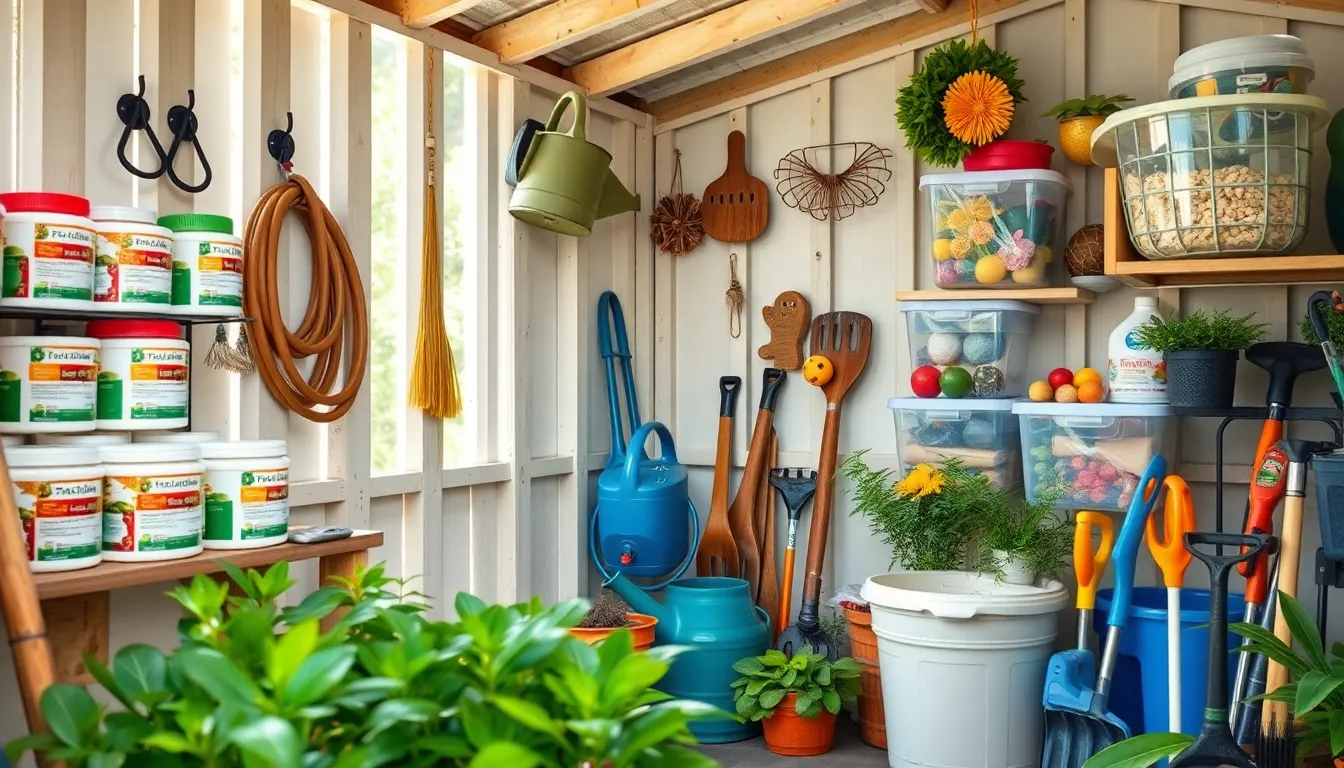
Building on our vertical gardening strategies, we’ll now focus on systematically organizing our garden supplies to create a more efficient and safer gardening environment.
Sort Fertilizers and Chemicals Safely
Designating a exact storage area with proper ventilation helps us keep fertilizers and chemicals secure while protecting our families and pets. We should establish this zone away from living spaces and ensure it remains consistently dry to prevent chemical degradation.
Labeling each container clearly prevents dangerous mix-ups and ensures we’re applying the right product at the right time. We recommend using waterproof labels that won’t fade or peel, especially for outdoor storage areas where moisture exposure is common.
Creating an inventory list of our chemical supplies allows us to track expiration dates and usage patterns effectively. This system helps us avoid purchasing duplicates while ensuring we’re using products within their recommended timeframes for maximum effectiveness.
Store Watering Equipment Efficiently
Hanging organizers transform our watering storage by keeping hoses and watering cans off the floor while making them instantly accessible. We can install wall-mounted hooks or specialized hose reels that prevent tangling and extend equipment lifespan.
Pressure washer storage requires a dedicated area that protects these valuable tools from weather damage and unauthorized use. We should choose a location that allows for proper drainage after use and provides easy access to power sources when needed.
Grouping watering accessories like sprinkler heads, nozzles, and timers in labeled bins creates a comprehensive irrigation station. This approach saves us time during watering sessions and ensures we have all necessary components readily available.
Organize Seasonal Decorations
Storage containers made from weatherproof materials protect our seasonal decorations like Christmas lights and summer lanterns from moisture and temperature fluctuations. We should invest in clear containers that allow us to see contents without opening each box.
Labeling each container with both contents and corresponding season creates an efficient retrieval system that saves us hours of searching. We can use color-coded labels where green indicates spring items, yellow for summer, orange for fall, and blue for winter decorations.
Creating a seasonal decoration calendar helps us plan storage rotations and ensures we’re prepared for upcoming holidays and seasons. This system prevents last-minute scrambling and allows us to maintain our garden’s aesthetic appeal year-round.
Build Functional Pathways and Garden Zones
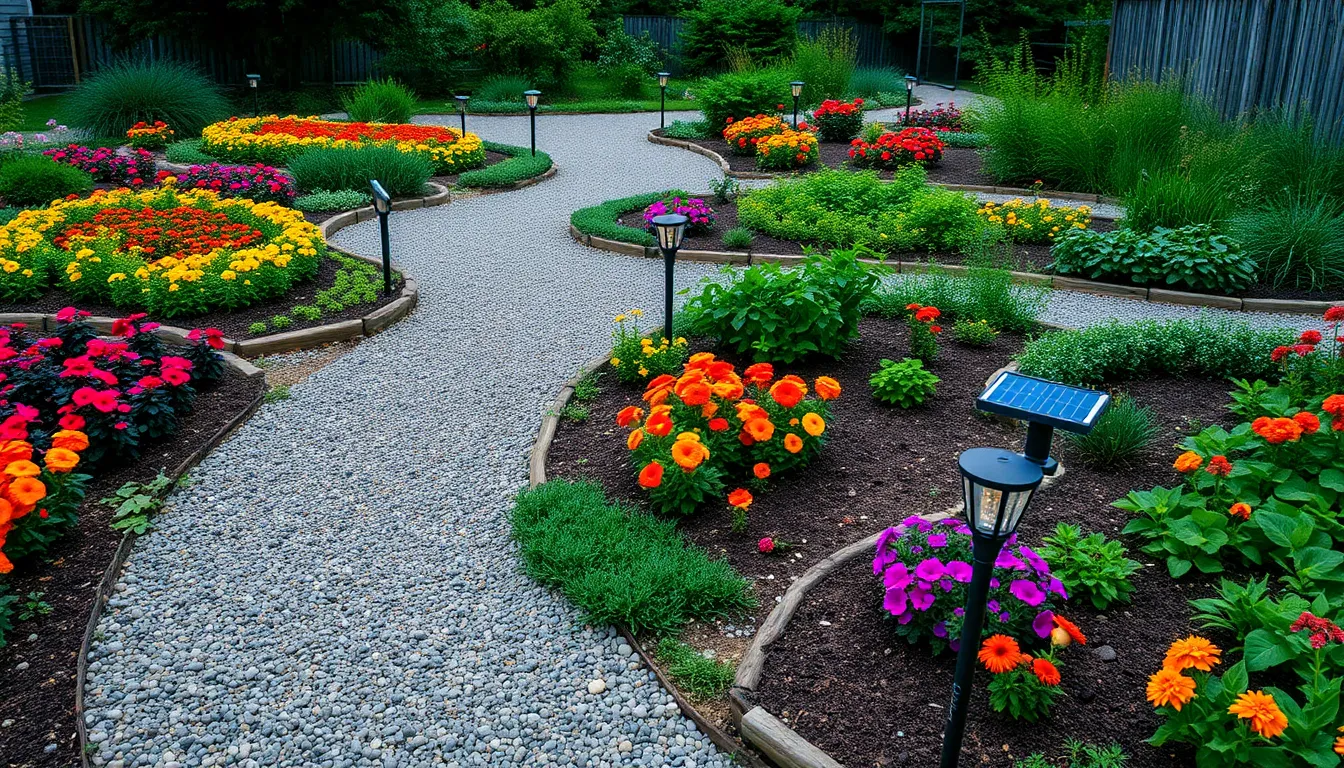
Strategic pathways and designated zones transform chaotic gardens into organized, efficient outdoor spaces. Well-planned circulation patterns create structure while maximizing growing potential.
Create Clear Walking Paths
Clear walking paths form the backbone of any organized garden layout. Wide pathways measuring at least three feet accommodate wheelbarrows and carts without damaging surrounding plants, ensuring smooth movement throughout your space. Materials like gravel, wood chips, or stone create stable surfaces that withstand weather while improving visual appeal.
Path lighting extends garden accessibility beyond daylight hours. Solar path lights eliminate the need for electrical connections while providing subtle illumination for evening maintenance tasks. Strategic placement prevents trips and falls while highlighting key garden features after dark.
Maintenance becomes effortless when paths connect all garden zones seamlessly. Curved pathways create natural flow while straight lines maximize efficiency for frequent trips between work areas and growing zones.
Designate Exact Growing Areas
Designated growing areas optimize space utilization and crop productivity through strategic planning. Plot gardens work exceptionally well by dividing available space into family-sized sections, particularly beneficial in community gardening situations where multiple gardeners share resources.
Shared spaces accommodate larger crops that exceed individual plot capacity. Corn stalks, fruit trees, and sprawling squash varieties thrive in communal areas while maximizing overall garden yield. These zones prevent overcrowding in personal plots while encouraging community cooperation.
Companion planting zones group compatible plants together for mutual benefit. Tomatoes paired with basil, carrots alongside onions, and beans near corn create natural pest deterrence while optimizing soil nutrients across designated growing areas.
Install Garden Border Markers
Garden border markers eliminate confusion while maintaining clear boundaries between different zones. Plant labels serve dual purposes by identifying exact varieties and marking territory boundaries. Store extra labels in designated containers like mason jars for quick access during planting seasons.
Visual markers create unmistakable boundaries using physical signs, stakes, or decorative elements. Weather-resistant materials ensure year-round visibility while complementing overall garden aesthetics. Color-coded systems help differentiate between vegetable plots, herb gardens, and flower beds at a peek.
Permanent markers like stone borders or metal edging define pathways while preventing soil erosion. These installations require minimal maintenance while providing lasting structure that guides both plants and foot traffic throughout your organized garden space.
Implement Water Management Organization
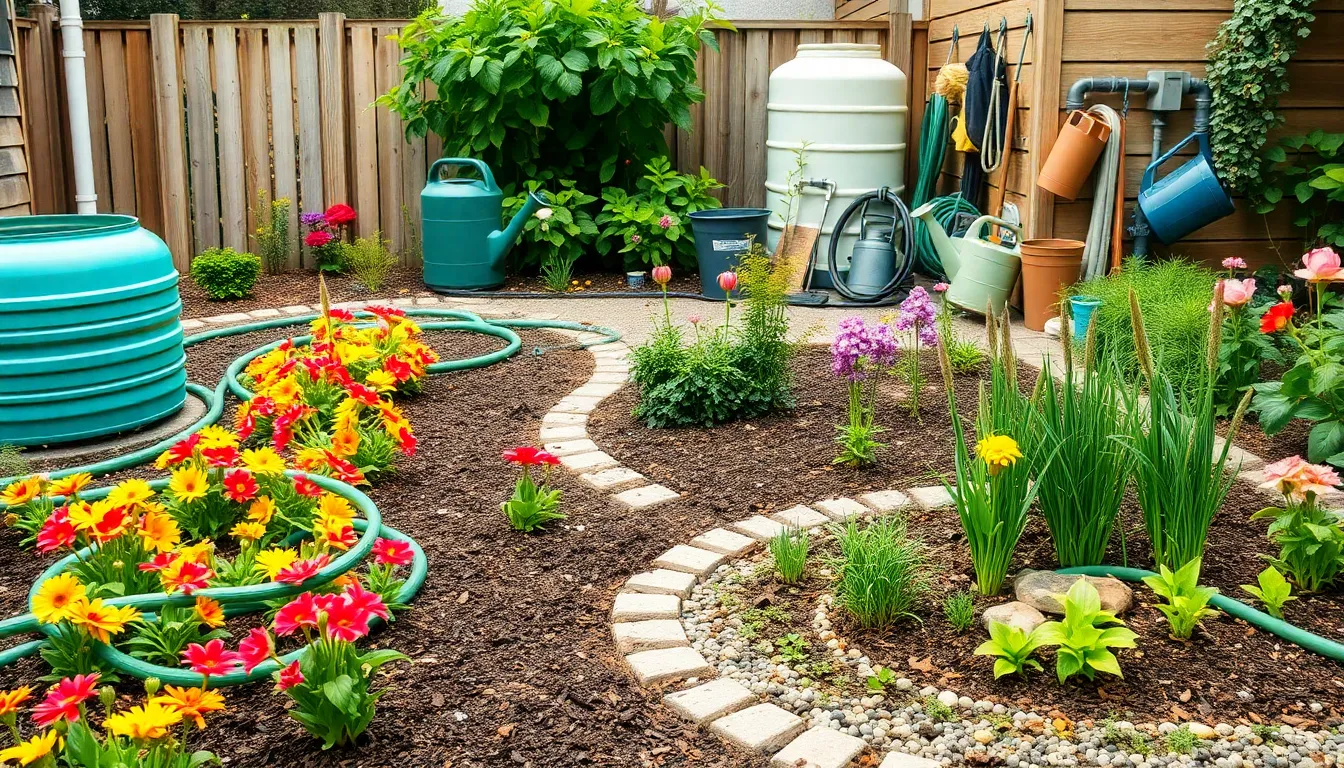
Water management organization forms the backbone of an efficient garden system. We’ll transform your garden’s water usage through strategic planning and smart equipment placement.
Set Up Efficient Irrigation Systems
Soaker hoses deliver water directly to plant roots while reducing evaporation by up to 50% compared to traditional sprinklers. We recommend installing these systems along garden beds and securing them with industry pins for consistent placement.
Drip irrigation systems provide precise water control for individual plants or garden zones. Installation involves connecting emitters to main water lines and adjusting flow rates based on plant needs. These systems excel in vegetable gardens where different crops require varying water amounts.
Rainwater tanks capture and store natural precipitation for later use during dry periods. We suggest positioning 50 to 100 gallon tanks near downspouts with screens to filter debris. Underground water storage systems offer larger capacity options while maintaining garden aesthetics.
Timer controls automate watering schedules and prevent overwatering or forgotten irrigation sessions. Smart timers adjust watering based on weather conditions and soil moisture sensors. We find programmable timers most effective for maintaining consistent plant care routines.
Organize Hoses and Watering Tools
Hose reels prevent tangling and extend hose lifespan through proper coiling and storage. Wall mounted reels work best near water sources while portable reels offer flexibility for larger gardens. We recommend choosing reels that accommodate your longest hose length plus 25 feet.
Designated tool stations centralize watering equipment in easily accessible locations throughout the garden. Create stations using weatherproof containers or small sheds positioned strategically near high maintenance areas. Include hooks for spray nozzles and shelving for watering attachments.
Clear labeling identifies hose purposes and lengths to streamline garden maintenance tasks. We use waterproof labels or colored tape to distinguish between soaker hoses, standard garden hoses, and specialty irrigation lines. Label both ends of each hose for quick identification.
Hose guides protect plants and garden borders from damage during watering activities. Install these guides at garden bed corners and pathway intersections where hoses frequently cross. Metal or plastic guides work equally well for directing hose movement.
Create Drainage Answers
Garden basins collect and redirect excess water away from sensitive plant areas and prevent waterlogged soil conditions. We construct these using shallow depressions lined with gravel or river rock. Position basins at natural low points where water naturally accumulates.
Rain gardens filter runoff while supporting native plant ecosystems in areas that receive concentrated water flow. Design these gardens 6 to 8 inches deep with drought resistant native plants that thrive in both wet and dry conditions. Strategic placement near downspouts maximizes water capture effectiveness.
Mulching improves soil water absorption and reduces surface runoff by creating permeable ground cover. Apply 2 to 3 inch layers of organic mulch around plants and garden beds. We prefer shredded bark or leaf mold for their water retention properties and soil improvement benefits.
French drains address persistent water accumulation in problem areas of the garden. Install perforated pipes surrounded by gravel in trenches that slope toward desired drainage areas. These systems work particularly well for gardens with clay soil or natural depressions that collect standing water.
Establish Maintenance and Cleaning Stations
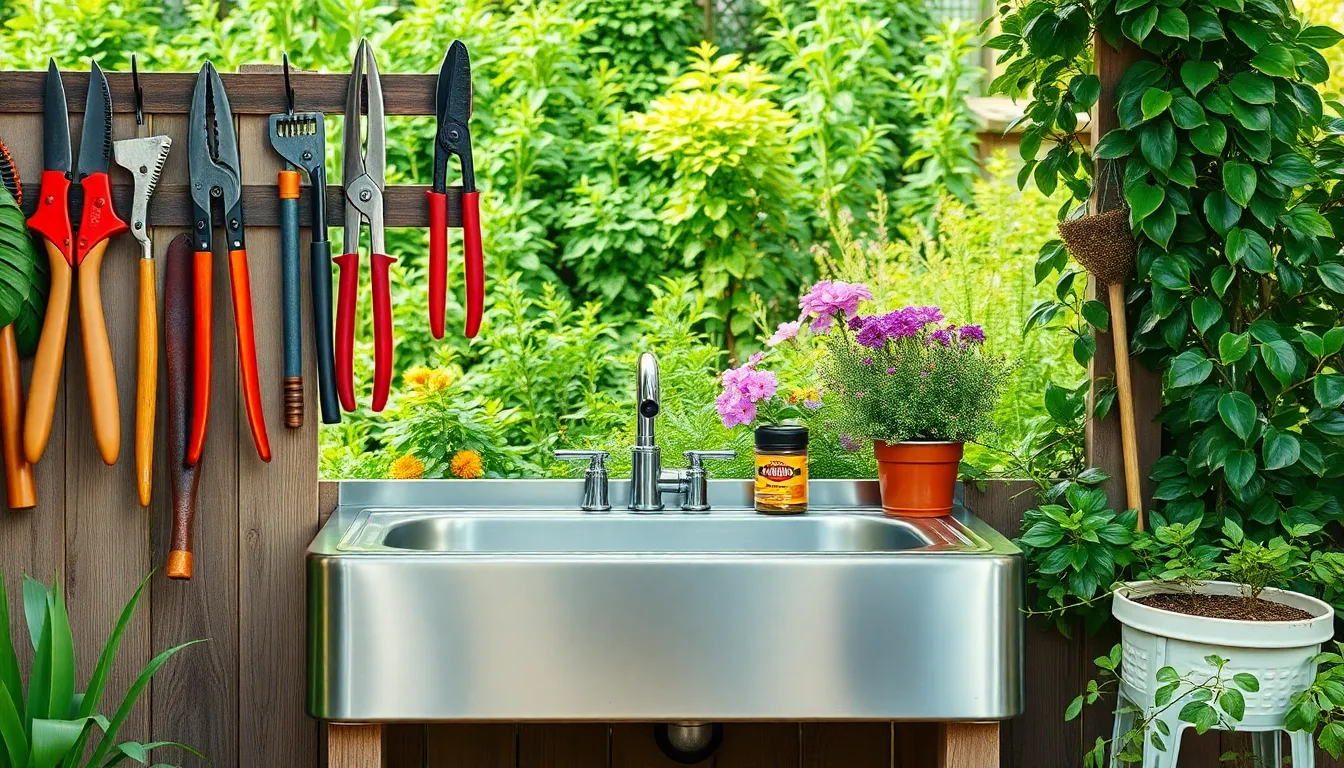
Dedicated maintenance and cleaning stations transform chaotic garden upkeep into streamlined workflows. These organized spaces keep essential tasks efficient while protecting our tools and extending their lifespan.
Design Outdoor Washing Areas
Outdoor sinks provide the foundation for effective garden cleaning stations. We recommend installing permanent fixtures with built-in water sources to handle everything from dirty tools to freshly harvested vegetables. Wall-mounted units save space while freestanding options offer flexibility for larger gardens.
Durable materials ensure your washing area withstands constant exposure to weather and heavy use. Stainless steel sinks resist rust and corrosion, while concrete or stone surfaces handle impact from heavy tools. Consider adding a splash guard to protect surrounding walls and surfaces.
Drainage systems prevent water buildup that attracts pests and creates muddy conditions. Install proper plumbing connections to municipal water or well systems for consistent water pressure. Add a utility sink sprayer attachment for thorough cleaning of stubborn soil and debris.
Organize Pruning and Trimming Tools
Hanging storage organizers keep cutting tools visible and easily accessible when we need them most. These specialized systems accommodate different tool sizes while protecting sharp edges from damage. Look for organizers with individual slots for pruning shears, loppers, and hand saws.
Tool hooks mounted on walls or door backs maximize vertical storage space efficiently. Install heavy duty hooks at varying heights to accommodate tools of different lengths. We suggest grouping similar tools together: hand pruners near eye level, long handled loppers on lower hooks.
Magnetic strips attached to workbench walls hold small metal tools like grafting knives and pruning snips. These strips keep frequently used items within arm’s reach during detailed work. Position them away from power tools to prevent interference with electronic components.
Create Compost Organization Systems
Modular compost bins offer the flexibility to expand your composting operation as needs grow. These stackable units separate different decomposition stages while maintaining easy access for turning and harvesting. We recommend systems with removable panels for convenient material addition and removal.
Clear labeling eliminates guesswork when managing multiple compost stages simultaneously. Use weatherproof labels to identify fresh materials, active compost, and finished product. Include dates on labels to track decomposition progress and rotation schedules.
Turning tools storage near compost areas streamlines the mixing process that accelerates decomposition. Dedicate space for pitchforks, compost aerators, and wheelbarrows used exclusively for compost management. Consider a small tool shed or cabinet to protect these implements from weather exposure.
Conclusion
Transforming your garden into an organized and efficient space doesn’t require a complete overhaul – it’s about implementing smart systems that work for your exact needs. We’ve covered everything from vertical growing answers to maintenance stations that’ll help you maximize both space and productivity.
The key is starting small and building upon each organizational element. Whether you’re creating dedicated work zones or establishing proper water management systems your garden will become more enjoyable and less stressful to maintain.
Remember that good garden organization saves time reduces frustration and eventually leads to better growing results. With these strategies in place you’ll spend less time searching for tools and more time enjoying the fruits of your labor.
Frequently Asked Questions
Why is organization important in gardening?
Organization in gardening saves time, reduces frustration, and enhances productivity. A well-organized garden eliminates the hassle of searching for misplaced tools, creates efficient workflows, and makes gardening more enjoyable. It also improves safety by properly storing chemicals and tools, while maximizing space utilization for better plant growth and easier maintenance.
What are the essential components of a garden work station?
A functional garden work station should include a customized potting bench with storage compartments, a sink for easy cleanup, labeled containers for supplies, and mobile carts for transporting tools. These elements consolidate essential activities like planting and soil mixing, making garden maintenance more efficient and accessible.
How should I organize and store my garden seeds?
Store seeds in airtight containers to protect against moisture and pests. Organize them by type or season in labeled boxes for easy access. Keep seeds in a cool, dry place and maintain an inventory list to track expiration dates and planting schedules for optimal germination success.
What are effective vertical gardening organization strategies?
Use tiered plant stands to create multiple growing levels, wall-mounted planters for herbs and strawberries, and hanging systems for trailing plants. Incorporate pulley systems for easier maintenance and self-watering planters to reduce upkeep. Ensure proper air circulation and sunlight penetration throughout your vertical garden setup.
How should I safely store fertilizers and garden chemicals?
Store fertilizers and chemicals in designated areas with proper ventilation and clear labeling to prevent dangerous mix-ups. Keep them away from children and pets, maintain an inventory list to track expiration dates, and follow manufacturer storage instructions. Use weatherproof containers and organize by type and frequency of use.
What makes an effective garden pathway system?
Create wide pathways using materials like gravel or wood chips to facilitate easy movement without damaging plants. Install path lighting for evening accessibility and maintain clear boundaries between different garden zones. Well-designed pathways improve workflow efficiency and prevent soil compaction in growing areas.
How can I organize my garden’s water management system?
Install efficient irrigation systems like soaker hoses or drip irrigation with timer controls for automated watering. Set up rainwater collection tanks and organize hoses at designated stations with clear labeling. Implement proper drainage solutions including garden basins, rain gardens, and French drains to prevent waterlogged soil.
What should I include in a garden maintenance station?
Create outdoor washing areas with durable materials and proper drainage for cleaning tools and vegetables. Organize pruning tools using hanging storage and magnetic strips. Set up modular compost bins with clear labeling for different decomposition stages. Include adequate lighting and weather protection for year-round functionality.

